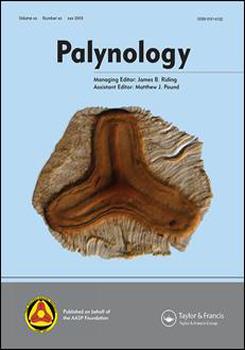We restudied the morphological complex comprising the cyst-based species Spiniferites elongatus/ Spiniferites frigidus/Rottnestia amphicavata. We reviewed existing studies, and acquired new morphometric measurements of recent cysts from across the Northern Hemisphere, scanning electron microscopy (SEM) observations of cysts from Barents Sea surface sediments, and genetic analyses of cysts from the Beaufort Sea. The measurements suggest that populations and morphospecies cannot be distinguished based on morphometric criteria. Furthermore, sequential sediment trap samples from Hudson Bay reveal that morphological variation can occur at the same location over a few weeks, arguing against a uniform morphological response to environmental parameters. The SEM observations reveal a consistent gonyaulacacean tabulation (Po, 4′, 6″, 6c, 5s, *6′″, 1p, 1″″). The small and large subunit ribosomal RNA genes and the internal transcribed spacer sequences obtained from differing cysts from the Beaufort Sea with morphologies attributable to the complex, including forms that correspond to Rottnestia amphicavata, were all identical and conform to those of Gonyaulax elongata from the Orkney Islands. The molecular analyses thus support the conclusion that the morphological variability is not reflected genetically and occurs within one species. Based on arguments against the generic attribution of amphicavata to Rottnestia, the continuum between the extreme ends of the morphological range, and the molecular data, we suggest Rottnestia amphicavata to be conspecific with Spiniferites frigidus, and both to be junior synonyms of Spiniferites elongatus. The morphometric data further indicate that Spiniferites ellipsoideus, an elongate cyst from the Miocene, can also be considered a junior synonym of Spiniferites elongatus. It is recommended to use two informal types in census work (i.e. Spiniferites elongatus – Beaufort morphotype for morphologies formerly assignable to Spiniferites frigidus/Rottnestia amphicavata, and Spiniferites elongatus – Norwegian morphotype for cysts with strongly reduced processes) to separate specimens at both extreme ends of the morphological spectrum from typical specimens of Spiniferites elongatus.
How to translate text using browser tools
1 December 2018
Taxonomic Revision of Spiniferites elongatus (The Resting Stage of Gonyaulax elongata) based on Morphological and Molecular Analyses
Nicolas Van Nieuwenhove,
Éric Potvin,
Maija Heikkilä,
Vera Pospelova,
Kenneth Neil Mertens,
Edwige Masure,
Małgorzata Kucharska,
Eun Jin Yang,
Nicolas Chomérat,
Marek Zajaczkowski
ACCESS THE FULL ARTICLE
It is not available for individual sale.
This article is only available to subscribers.
It is not available for individual sale.
It is not available for individual sale.

Palynology
Vol. 42 • No. S1
December 2018
Vol. 42 • No. S1
December 2018
morphologic variability
Rottnestia amphicavata
Single-cell PCR
Spiniferites ellipsoideus
Spiniferites frigidus
taxonomy




